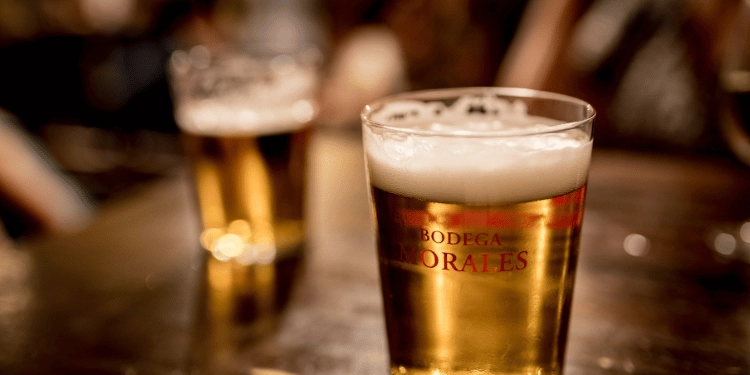5 Essential Safety Tips for Drinking Alcohol
Anúncios
Understanding Alcohol’s Impact
Alcohol consumption has a profound impact on global health, with alarming statistics and notable effects on the human body.
In 2019, alcohol consumption was responsible for 2.6 million deaths worldwide, showcasing the grave consequences associated with its use.
Anúncios
The deaths stem from various conditions directly attributed to alcohol, such as heart disease and liver disease, along with fatalities from alcohol-related incidents like accidents and suicides.
COVID-19 and Alcohol Consumption
The advent of the COVID-19 pandemic has further intensified alcohol use and its associated risks.
Anúncios
The stress, isolation, and uncertainty brought on by the pandemic have led many individuals to increase their alcohol intake as a coping mechanism.
As a result, the adverse effects of alcohol have become an even more pressing issue.
Effects of Alcohol on the Body
Alcohol’s impact on the body is multifaceted and includes impaired reaction time, diminished motor coordination, and compromised judgment.
These effects can lead to dangerous situations, impaired decision-making, and increased risk of accidents.
Even in social settings, while alcohol is often perceived as a social enhancer, research suggests that the boost in sociability may smte more from perceived beliefs and expectations than from the alcohol itself.
 Drink responsibly
Drink responsibly
Mindset and Perception
An innovative experiment at the University of Washington’s BAR lab revealed interesting insights about alcohol and social interaction.
Participants who thought they consumed alcohol showed increased sociability, even when their drinks were alcohol-free.
This indicates that our mindset and expectations play a significant role in how we experience social situations involving alcohol.
Conversely, those actually consuming alcohol showed no significant increase in social benefits compared to those who only believed they had consumed it.
Conclusion
Understanding alcohol’s impact is crucial in making informed decisions about consumption.
Being aware of its extensive risks helps in adopting safer drinking practices.
Moving forward, it’s important to consider strategies for reducing harm and managing consumption effectively.
Tip 1: Smart Consumption Choices
It’s important to consider making smart choices when it comes to drinking alcohol.
One effective option is to choose alcohol-free alternatives.
These choices not only help you avoid the negative effects of alcohol but also contribute to a healthier lifestyle.
With plenty of creatively crafted non-alcoholic beverages available, you don’t have to feel left out during social gatherings.
Alternating alcoholic drinks with water is another smart move.
This method helps you pace your drinking, avoiding the rapid onset of alcohol’s impairing effects.
It also keeps you hydrated throughout the event, reducing the likelihood of a hangover the next day.
Simply put, taking a water break between alcoholic drinks can make a world of difference in how you feel during and after drinking.
Reducing overall alcohol consumption is a sensible approach to minimize unwanted effects.
By drinking less, you lower the risks of impaired reaction time, motor coordination, and judgment.
This is especially crucial given that poor decision-making under the influence can lead to accidents and other dangerous situations.
Dr. Jason Kilmer, an associate professor at the University of Washington, suggests that our perceived sociability may be less about the alcohol itself and more about our expectations and mindset.
This insight further underlines the importance of making informed and deliberate choices when consuming alcohol.
Taking these steps towards smart consumption can significantly reduce the negative impacts of alcohol on your health and well-being.
As we continue exploring safe drinking practices, the next tip will focus on the relationship between eating and drinking wisely.
Tip 2: Eating and Drinking Wisely
The Importance of Eating Before Drinking
One crucial rule of drinking is to never do it on an empty stomach.
When you drink alcohol without having eaten, the alcohol is absorbed much more quickly into your bloodstream.
This rapid absorption can lead to higher blood alcohol concentration (BAC) levels, causing you to feel the effects of the alcohol much faster and more intensely.
How Food Helps
Eating before or while you are drinking plays a significant role in moderating the effects of alcohol.
Here’s why:
- 🍺 Slows Absorption: Food in your stomach slows down the rate at which alcohol enters your bloodstream. This results in a lower and more gradual increase in your BAC.
- 🍺 Reduced Intensity: By slowing alcohol’s absorption, eating helps diminish the intensity of alcohol’s effects, making your drinking experience safer and more enjoyable.
What to Eat
When it comes to what you should eat, opt for nutrient-dense foods rich in proteins and healthy fats.
These types of foods are digested more slowly, providing a sustained release of energy and maintaining a slower absorption rate for any alcohol consumed.
- Examples: Think of high-protein snacks like nuts, cheese, and meats, and healthy fats from avocados or olive oil-based dishes.
Practical Steps
To put these tips into practice:
- Plan Ahead: If you know you’ll be drinking, eat a hearty meal with plenty of protein and fats beforehand.
- Snack Smart: Keep healthy snacks on hand to eat as you drink, ensuring your stomach isn’t empty at any point during your drinking session.
Eating before and while drinking isn’t just a guideline—it’s a tried-and-true method for mitigating the negative effects of alcohol.
Making this a habit can greatly enhance your safety and enjoyment when you choose to drink.
As we continue exploring more ways to make smart drinking choices, stay tuned for our next tip designed to help you understand standard drink measurements and their importance in managing alcohol intake effectively.
Tip 3: Understanding Standard Drinks
Measuring One Standard Drink
Understanding what constitutes a standard drink is key to tracking alcohol intake responsibly.
A standard drink in the U.S. contains approximately 14 grams of pure alcohol. This amounts to:
- 🍺 12 ounces of beer (5% alcohol)
- 🍺 5 ounces of wine (12% alcohol)
- 🍺 1.5 ounces of distilled spirits (40% alcohol or 80 proof)
Recognizing these measurements helps manage alcohol consumption more effectively, reducing the risk of over-drinking.
Track Servings, Not Glasses
Counting just the number of glasses doesn’t always give an accurate picture of how much alcohol you’ve consumed.
Mixed drinks, for instance, can contain multiple standard servings.
A single cocktail might have two or more shots of liquor, meaning it could be equivalent to two standard drinks.
When you’re out, it’s crucial to keep track of the number of standard drinks rather than the number of glasses.
This practice can prevent overconsumption and help you stay within safe drinking limits.
Mixed Drink Awareness
While a single standard drink is easy to measure, mixed drinks can be deceptive.
A measure that seems like a single drink might actually be two or three times more potent, depending on the alcohol content and quantity of the ingredients involved.
Understanding this helps in monitoring alcohol intake accurately when enjoying cocktails or other mixed beverages.
Practical Tips for Tracking Standard Drinks
- Use Apps or Tools: Utilize mobile applications designed for counting and monitoring standard drinks. They simplify tracking and often come with features to alert you when you’ve consumed more than you intended.
- Educate Yourself: Familiarize yourself with the common alcohol content of the drinks you frequently consume. This knowledge empowers you to make informed choices.
- Read Labels: Check the alcohol by volume (ABV) percentages on beverage labels. Beers, in particular, can vary significantly in strength.
Transition
Understanding the amount of alcohol in each drink is a big step towards safer consumption habits.
Next, we’ll explore how the carbonation in your drinks can influence alcohol absorption and its effects on your body.
Tip 4: Carbonation Awareness
When it comes to drinking alcohol, not all beverages affect you in the same way.
One crucial aspect to consider is carbonation.
Carbonated drinks like champagne, sparkling wines, and fizzy cocktails can lead to faster alcohol absorption, impacting how quickly you feel their effects.
Faster Absorption
The bubbles in carbonated beverages can speed up the process of alcohol entering your bloodstream.
This happens because the carbonation can cause the pyloric valve (which controls food passage from your stomach to your intestine) to open more quickly.
This leads to alcohol being absorbed faster through the intestinal lining, making you feel intoxicated more rapidly compared to still beverages.
Champagne and Sparkling Drinks
If you’ve ever had champagne or any sparkling beverage, you might have noticed that you feel its effects more quickly than other alcoholic drinks.
This is due to the carbonation. It’s this rapid absorption that makes these drinks particularly potent and their effects more immediate.
Non-Carbonated Mixers
To slow down the absorption of alcohol, consider choosing non-carbonated mixers.
A vodka tonic, for example, will hit you faster than a vodka cranberry due to the tonic’s carbonation.
Opting for non-carbonated mixers helps slow the absorption process, giving your body more time to metabolize the alcohol gradually.
Being mindful of your drink choices, specifically concerning carbonation, can significantly impact your drinking experience and its aftermath.
As you make these informed decisions, you also pave the way for safer drinking practices overall.
Tip 5: Drink Safety and Awareness
Know Exactly What’s In Your Drink
One of the most crucial aspects of drink safety is knowing exactly what you’re consuming.
It’s essential to be aware of the types and amounts of alcohol and mixers in your drink.
If you’re at a bar, don’t hesitate to ask your bartender about the drink’s content.
When you’re at a party, mixing your own drink can give you control over what goes into it.
Making sure your drink only contains what you expect helps you avoid ingesting too much alcohol or any unwanted substances.
Never Leave Drinks Unattended
An essential rule to follow when drinking is to never leave your drink unattended.
You may have heard this advice countless times, but it’s not cliché, it’s crucial. In social settings, there’s always a risk that someone could tamper with your drink.
This is not just about alcohol content; malicious substances can be added if your drink is not in your sight.
Stay vigilant and take your drink with you if you have to step away.
Be Cautious About Accepting Drinks from Unknown Sources
Accepting drinks from strangers can sometimes come with risks.
A drink from someone you don’t know may contain more alcohol than you are used to, or even substances you’re not aware of.
Politely decline if someone you do not know offers you a drink, especially in settings where you can’t verify their intentions.
Always ensure your safety by obtaining your own drinks from a trusted source.
Staying aware of what’s in your drink, never leaving it unattended, and being cautious about accepting drinks from unknown sources are fundamental practices in ensuring your safety while drinking.
These tips help create an environment where you can enjoy social activities while minimizing risks associated with alcohol consumption.
As we strive to understand the effects, causes, and safety measures around alcohol, let’s delve into more practical ways to safeguard ourselves and our loved ones.







